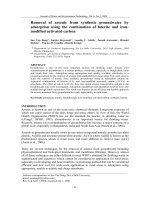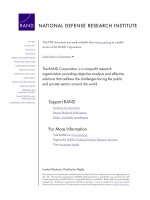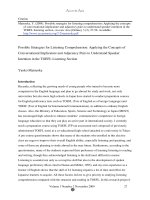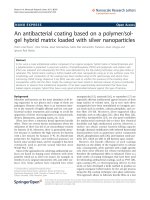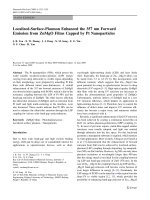Applying activated carbon derived from coconut shell loaded by silver nanoparticles to remove methylene blue in aqueous solution
Bạn đang xem bản rút gọn của tài liệu. Xem và tải ngay bản đầy đủ của tài liệu tại đây (1.77 MB, 71 trang )
THAI NGUYEN UNIVERSITY
UNIVERSITY OF AGRICULTURE AND FORESTRY
VU THI THAO
Applying activated carbon derived from coconut shell loaded
by silver nanoparticles to remove methylene blue in aqueous solution
BACHELOR THESIS
Study Mode
: Full-Time
Major
: Environmental Science and Management
Faculty
: Advanced Education Program
Batch
: 2014 – 2018
Thai Nguyen, 15/09/2018
DOCUMENTATION PAGE WITH ABSTRACT
Thai Nguyen University of Agriculture and Forestry
Degree program:
Bachelor of Environmental Science and Management
Student name:
Vu Thi Thao
Student ID:
DTN1454120218
APPLYING ACTIVATED CARBON DERIVED
FROM COCONUT SHELL LOADED BY SILVER
Thesis Title:
NANOPARTICLES TO REMOVE METHYLENE
BLUE IN AQUEOUS SOLUTION
Dr. Van Huu Tap - Faculty of Environment and Earth
Supervisor(s):
Science, Thai Nguyen University of Sciences (TNUS)
Supervisor’s signature:
Abstract:
In this study, Coconut shell activated carbon loaded silver nanoparticles (AgNP-AC) with 0.5% (w/w) was investigated to remove Methylene Blue (MB) from
aqueous solution. The influence of various experimental factors such as pH, contact
time, adsorbent dose and initial dye concentration of MB was investigated. The
results indicated that the highest adsorption capacity of sucrose onto MAC reached
when the AC was loaded AgNPs at the ratio of impregnation of AC and AgNPs was
0.5% (w/w). The suitable condition for removal of MB by Ag-NP-AC occurred at
pH 10, contact time of 120 minutes and adsorbent dose of 250 mg/25 mL solution.
At this condition,the maximum adsorption capacity of MB onto Ag-NP-AC achieved
i
at 172.22 mg/g. The adsorption equilibrium was represented with Langmuir,
Freundlich and Sips models. The Langmuir equations were found to have the
correlation coefficient value (0.935) in good agreement. The pseudo first and second
order kinetic model agrees very well with the dynamic behavior of the adsorption of
dye MB on Ag-NP-AC.
Sliver nanoparticle, Activated carbon, (Ag-NP-AC),
Key-words:
Methylene blue, Adsorption
Number of pages:
59
Date of submission:
15/09/2018
ii
ACKNOWLEDGEMENT
I would like to express my deepest appreciation to all those who provided me the
opportunity to complete this research.
Foremost, I could like to express my sincere gratitude and deeps regards to my
supervisor: Dr. Van Huu Tap of Thai Nguyen University of Science who guided me
wholeheartedly when I implement this research. He also offered me a warm welcome,
assisted me with a new treatment for blue methylene in this dissertation; he was very
patient with my knowledge gaps and gave me opportunity to use the research facilities
in his department – Faculty of Environment and Earth Science, Thai Nguyen University
of Sciences (TNUS),
I gratefully acknowledge Dr. Hoa, Laboratory of Physics, Thai Nguyen
University of Science for helping and providing me necessary of equipment as well as
knowledge for creating sliver nanoparticles.
I also want to express my thanks to the Dean of Faculty of Environment and Earth
Science, Prof. Dr. Ngo Van Gioi and Director of Thai Nguyen University of Sciences
(TNUS), Prof. Dr. Le Thi Thanh Nhan who gave the permission to use all required
equipment and the necessary materials to conduct my research in Laboratory of Faculty
of Environment and Earth Science, Thai Nguyen University of Sciences (TNUS).
I wish to thank the technicians who are Kien and Trung , Laboratory of Faculty
of Environment and Earth Science, Thai Nguyen University of Sciences (TNUS) for
their help in tissue preparation.
Special thanks to Luyen, Huyen, Quynh, Lan, Thien, Lan Anh, Minh, Giang and
all people who helped me when I stayed in Thai Nguyen University of Science.
iii
My sincere thanks also go to all my classmates – K46N01 AEP for helping me
finish this the study.
Finally, I could like to thank my family, for their love and supporting me
throughout my life.
Thai Nguyen, September 15, 2018
Student
VU THI THAO
iv
TABLE OF CONTENTS
LIST OF FIGURES ..................................................................................................... viii
LIST OF TABLES .......................................................................................................... x
LIST OF ABBREVIATIONS ........................................................................................ xi
PART I. INTRODUCTION ............................................................................................ 1
1.1. Research rationale .................................................................................................... 1
1.2. Research’s objectives ............................................................................................... 2
1.3. Research questions and hypotheses ......................................................................... 3
1.4. Limitations ............................................................................................................... 3
PART II. LITERATURE REVIEW ............................................................................... 4
2.1. Textile Dyes Waste .................................................................................................. 4
2.1.1. Source of Textile Dyes Waste .............................................................................. 4
2.1.2. Impact of Textile Dyes Waste .............................................................................. 4
2.2. Methylene blue......................................................................................................... 5
2.2.1. Source of Methylene blue. .................................................................................... 5
2.2.2. Chemical and physical data of Methylene blue .................................................... 6
2.2.3. Adverse effects of Methylene blue ....................................................................... 8
2.3. Introduction to adsorption techniques.................................................................... 10
2.3.1. Concepts .............................................................................................................. 10
2.3.2. Modeling and Interpretation of Adsorption Isotherms ....................................... 11
2.3.2.1. Langmuir Isotherm........................................................................................... 11
2.3.2.2. Freundlich Isotherm ......................................................................................... 12
2.3.2.3. Adsorption kinetics models ............................................................................. 13
2.3.3. Factors Affecting Adsorption ............................................................................. 13
v
2.4. Absorption material ............................................................................................... 14
2.4.1. Silver Nanoparticles ............................................................................................ 14
2.4.1.1. Definitions........................................................................................................ 14
2.4.1.2. Synthesis of silver nanoparticles...................................................................... 16
2.4.1.3. Applications ..................................................................................................... 19
2.4.2. Coconut Shell Based Activated Carbon.............................................................. 20
2.4.2.1. Features ............................................................................................................ 20
2.4.2.2. Specification of Coconut Shell Based Activated Carbon: .............................. 21
2.4.2.3. Coconut Shell Activated Carbon Types: ......................................................... 21
2.4.2.4. Applications ..................................................................................................... 22
PART III. MATERIALS AND METHODS ............................................................... 24
3.1 Materials ................................................................................................................. 24
3.1.1 MB, Ag-NP-AC ................................................................................................... 24
3.1.3. Equipments ......................................................................................................... 25
3.2. Methodology .......................................................................................................... 26
3.2.1. Experimental method .......................................................................................... 26
3.2.1.1. Preparation of silver nanoparticles .................................................................. 26
3.2.1.2. Preparation of the AgNPs-loaded activated carbon (Ag-NP-AC) ................... 26
3.2.2. Data processing methods .................................................................................... 30
PART IV. RESULTS AND DISCUSSION ................................................................. 33
4.1. Adsorbent property ................................................................................................ 33
4.2. Effect of impregnation ratio (Ag/AC) on Methylene blue adsorption .................. 36
4.3. Effect of pH............................................................................................................ 37
4.4. Effect of contact time ............................................................................................. 39
vi
4.5. Effect of absorbent dose ........................................................................................ 40
4.6. The effect of initial MB concentration .................................................................. 42
4.7. Adsorption isotherm............................................................................................... 43
4.8. Adsorption kinetics of Ag-NP-AC ........................................................................ 45
PART V. CONCLUSION............................................................................................. 47
REFERENCES ............................................................................................................. 48
vii
LIST OF FIGURES
Figure 2.1. Typical scanning electron microscope (SEM) and transmission electron
microscope (TEM) image of different types of 0D NSMs, which is synthesized by
several research groups. (A) Quantum dots , (B) nanoparticles arrays, (C) core–shell
nanoparticles, (D) hollow cubes, and (E) nanospheres. Reprinted by permission of the
Wiley-VCH Verlag GmbH & Co. KGaA J.N. Tiwari et al. / Progress in Materials
Science 57 (2012) 724–803 .......................................................................................... 16
Figure 4.1. SEM image of (a) AC and (b) AgNPs-loaded activated carbon (Ag-NP-AC),
EDS spectra of (c) AC and (d) AgNPs-loaded activated carbon (Ag-NP-AC) ............ 33
Figure 4.2. XRD graph of (a) activated carbon from coconut shells (AC) and (b) AgNPsloaded activated carbon (Ag-NP-AC)........................................................................... 34
Figure 4.3. FTIR graph of AC and Ag-NP-AC ............................................................ 35
Figure 4.4. The effect of the impregnation ratio on MB adsorption at concentration: 500
mg/L, adsorbent dose: 50 mg Ag-NP-AC/25 mL solution and temperature: 25oC. ..... 36
Figure 4.5. Effect of pH on MB adsorption at concentration: 500 mg/L, adsorbent dose:
50 mg Ag-NP-AC/25 mL sulotion, time: 60 min, temperature: 25oC (a) and pHPZC of
AC, Ag-NP-AC before and after adsorption of MB (b) ............................................... 38
Figure 4.6. Effect of contact time on MB adsorption at pH 10, concentration: 500 mg/L,
adsorbent dose: 50 mg Ag-NP-AC/25 mL solution and temperature: 25oC. ............... 39
Figure 4.7. Effect of Ag-AC dosage on MB adsorption at pH 10, time: 120 min, ...... 41
MB concentration: 500 mg/L, temperature: 25oC ........................................................ 41
Figure 4.8. Effect of initial MB concentrations on the adsorption of MB by Ag-NP-AC at pH
10, time: 60 min, adsorbent dose: 250 mg/25 mL and temperature: 25oC ......................... 42
viii
Figure 4.9. Adsorption isothermal equilibrium prediction of MB onto Ag-NP-AC at
contact time = 120 min, Ag-NP-AC dose = 250 mg/25mL) ........................................ 44
Figure 4.10. Kinetics model of MB adsorption onto Ag-NP-AC (Co: 500mg/L; adsorbent
dosage: 50 mg/25 mL; initial pH: 10, temperature: 25oC) ........................................... 45
ix
LIST OF TABLES
Table 2.1 shows a comparison of physical and chemical adsorption. .......................... 11
Table 2.2: Specification of Coconut Shell Based Activated Carbon ............................ 21
Table 2.3: Physical and chemical analysis to the common coconut activated carbon:
Inspection standard: GB/T 7702-1997 .......................................................................... 22
Table 4.1: Adsorption isothermal parameters and correlation coefficients of Langmuir,
Freundlich and Sips models for sucrose adsorption on MAC ...................................... 45
Table 4.2. Calculated kinetic parameters of models of MB adsorption on Ag-NP-AC........ 46
x
LIST OF ABBREVIATIONS
Abbreviation
Explanation
MB
Methylene Blue
AC
Activated carbon
AgNPs
Siler Nanoparticles
Ag-NP-AC
Activated Carbon loaded Silver Nanoparticles
SEM
Scanning Electron Microscope
TEM
Transmission Electron Microscope
COD
Chemical Oxygen Demand
xi
PART I. INTRODUCTION
1.1. Research rationale
The high level of organic compounds from human activities usually causes
harmful effective the living organism. Dyes are one of the big challenges for water
resources. A lot of dyes are used in various industries such as textile, rubber,
carpet, paper, printing, etc (Sara and Tushar 2014, Shu et al., 2015). The discharge
of dyes into a water resource leads to many serious environmental and health
problems (Hamadi et al., 2017). Most of the dye cause water colourization at very
low concentrations leading to serious ecological problems as destroying aquatic
organisms and harming human (Stoyanova and Christoskova 2011, Chen et al.,
2018). Numerous conventional treatment techniques have been applied to remove
dye – containing wastewater, such as oxidation, electrochemical techniques,
biological treatment, coagulation, and adsorption (De Castro et al., 2018). Among
such existing methods, adsorption has been acknowledged to be the most
economically favorable method for removing organic compounds from
wastewater.
Recently, nanotechnology is not only created a breakthrough in electronics
(Kritika et al., 2010), informatics and biomedical technology (Ganau et al., 2018),
but also is widely applied in our life. Nano materials have excellent motorized and
physical properties due to their extremely fine grain size and high grain boundary
volume fraction (Krishnananda et al., 2017). Silver nanoparticles (AgNPs) have
been used extensively in therapeutic applications such as catheters, surgical
devices and wound dressings (Tang et al., 2017). However, the production of
1
AgNPs is expensive leading to a decrease in applied potential for removing
pollutants from wastewater.
Activated carbon with very large internal surface areas makes particularly
attractive for removal of contaminants from water, soil and air (Kumar and
Meikap, 2014). To date, the adsorption process is the simple and effective method
for removing dye and other organic compounds from wastewater (Fontoura et al.,
2017). Activated carbon was also modified with H P0 (Fierro et al., 2006),
H S0 (Singh et al., 2008), ZnCl (Yorgun et al., 2009), HNO (Lopes et al., 2015),
NaOH (Vu et al., 2017) etc… to enhance the adsorption capacity. However, there
is still no study focus on the mix of activated carbon and silver nanoparticles as a
modified material for removing one kind of dye from aqueous solution. With huge
surface area and proper microspore, activated carbon is an ideal supporting
material for loading AgNPs (Tang et al., 2017, Abe et al., 2000, Chingombe et al.,
2006). This study therefore focuses on loaded AgPNs on the activated carbon to
use as an adsorbent to remove methylene blue.
1.2. Research’s objectives
In this study, activated carbon derived from coconut shell loaded by silver
nanoparticles used as a low-cost sorbent for the removal of methylene blue from
in aqueous water. The influences of various parameters such as contact time, pH,
sorbent dosage, and initial Methylene blue concentration on adsorption were
evaluated.
2
1.3. Research questions and hypotheses
* Research questions:
How does activated carbon derived from coconut shell loaded by silver
nanoparticles adsorb Methylene blue in aqueous water?
* Hypotheses
(Null Hypothesis): activated carbon derived from coconut shell loaded by silver
nanoparticles will not adsorb Methylene blue in aqueous water.
(Alternative Hypothesis): activated carbon derived from coconut shell loaded
by silver nanoparticles will adsorb Methylene blue in aqueous water.
1.4. Limitations
In the laboratory do not have enough machines therefore some parts have to
send to another laboratory in Hanoi to obtain the result.
3
PART II. LITERATURE REVIEW
2.1. Textile Dyes Waste
2.1.1. Source of Textile Dyes Waste
One of the oldest and most technologically complex of all industries is the
textile production industry. Textile product has also been raised dramatically
because of the increasing demand of the population. Textile mills and their waste
water have been increasing proportionally, causing a major problem of pollution
in the world. The textile industry accounts for two thirds of the total dyestuff
market. During dyeing process approximately 10-15% of the dyes used are
released in to the waste water. It is recognized as the root cause of environmental
pollution. Recently, much textile industries are located in developing countries
such as India, Vietnam, etc. often equipped with poor wastewater system.
However, India is one of the major contributors of textile waste water in south
Asia. In India, Maharashtra and Gujarat account for 90% of dye-stuff production
due to the availability of raw materials and dominance of textile industry in these
regions (CATR, 2018).
2.1.2. Impact of Textile Dyes Waste
A numerous chemicals used in the textile industry cause environmental and
health problems. Recently, in textile waste water are considered as important
pollutants. Globally, environmental problems related with the textile industry are
those associated with water pollution caused by the direct discharge of untreated
effluent and release of toxic chemicals in to the aquatic environment. It drastically
declines oxygen concentration in water body due to the presence of hydrosulfides
and blocks the passage of light through water body which is detrimental to the
4
water ecosystem. Untreated or incompletely treated textile effluent can be harmful
to both aquatic and terrestrial life by adversely affecting the natural ecosystem and
causing long-term health effects. Due to high thermal and photo stability to resist
biodegradation dyes can remain in the environment for an extended period of time.
The greater environmental concern with dyes is their absorption and
reflection of sunlight entering the water. Light absorption diminishes
photosynthetic activity of algae and influences the food chain. High concentrations
of textile dyes in water bodies stop the oxygenation capacity of the receiving water
and cut-off sunlight, thereby upsetting biological activity in aquatic life and also
the photosynthesis process of aquatic plants or algae (Zaharia et al., 2009). The
polluting effects of days against aquatic environment can be the result of toxic
effects due to their long time presence in environment (i.e. half-life time of several
years), accumulation in sediments especially in fishes or other aquatic life forms,
decomposition of pollutants in carcinogenic or mutagenic compounds and also low
aerobic biodegradability. Many dues and their break down products are
carcinogenic, mutagenic and/or toxic to life. The presence of very small amounts
of days in the water be highly visible, seriously affects the quality and transparency
of water bodies such as lakes, rivers and others, leading to damage to the aquatic
environment.
2.2. Methylene blue (
.
O)
2.2.1. Source of Methylene blue.
Methylene blue was originally synthesized in 1876 as an aniline-based dye
for the textile industry (Berneth, 2008), but scientists such as Robert Koch and
Paul Ehrlich were quick to realize its potential for use in microscopy stains
5
(Ehrlich, 1881; Oz et al., 2011). The observation of selective staining and
inactivation of microbial species led to the testing of aniline-based dyes against
tropical diseases (Oz et al., 2011). Methylene blue was the first such compound to
be administered to humans, and was shown to be effective in the treatment of
malaria (Guttmann & Ehrlich, 1891; Oz et al., 2011). Methylene blue was also the
first synthetic compound ever used as an antiseptic in clinical therapy, and the first
antiseptic dye to be used therapeutically. In fact, the use of methylene blue and its
derivatives was widespread before the advent of sulfonamides and penicillin (Oz
et al., 2011).
2.2.2. Chemical and physical data of Methylene blue
• Nomenclature
Chem. Abstr. Serv. Reg. No.: 61-73-4 (anhydrous); 7220-79-3 (methylene
blue trihydrate) According to recent research, methylene blue occurs in the form
of several different hydrates, but not as trihydrate (Rager et al., 2012). [The
Working Group noted that most of the scientific literature refers only to
“methylene blue” independent of hydration state. Due to its hygroscopic nature,
commercial methylene blue is typically sold as the hydrate, but is sometimes
incorrectly presented as the trihydrate.]
Chem. Abstr. Serv. Name: Phenothiazin- 5-ium, 3,7-bis(dimethylamino)-,
chloride (O’Neil et al., 2006).
Synonyms: Aizen methylene blue; Basic blue 9 (8CI); Calcozine blue ZF;
Chromosmon; C.I. 52015; Methylthionine chloride; Methylthioninium chloride;
Phenothiazine-
5-ium,3,7-bis,
(dimethylamino)-,
6
chloride;
Swiss
blue;
Tetramethylene blue; Tetramethyl thionine chloride (NTP., 2008; PubChem.,
2013).
• Structural and molecular formulae and relative molecular mass
C H CIN S
Relative molecular mass (anhydrous form): 319.85 (PubChem, 2013)
• Chemical and physical properties of the pure substance
Description: Dark green crystals or crystalline powder with bronze lustre,
odourless, stable in air, deep blue solution in water or alcohol, forms double salts
(PubChem., 2013)
Melting point: 100–110 °C (decomposition) (PubChem, 2013) Density: 1.0
g/mL at 20 °C (ChemNet, 2013) Solubility: 43.6 g/L in water at 25 °C; also soluble
in ethanol (PubChem., 2013)
Vapour pressure: 1.30 × 10
!
mm Hg at 25 °C (estimated) (PubChem.,
2013)
• Technical products and impurities
Trade names: Desmoid piller; desmoidpillen; panatone; urolene blue;
vitableu (NTP., 2008)
7
Impurities:
*,
3-Amino-7-(dimethylamino)
phenothiazin-5-ium
chloride
(azure
A)
(PubChem., 2013)
*, 3-(Dimethylamino)-7-(methylamino) phenothiazin-5-ium chloride or N,N,N'trimethylthionin (azure B) (PubChem., 2013)
*, 3-(Amino)-7-(methylamino) phenothiazin-5-ium chloride (azure C) (PubChem.,
2013)
2.2.3. Adverse effects of Methylene blue
In humans, large doses of Methylene blue (~500 mg) have been reported to
cause nausea, abdominal and chest pain, cyanosis, methaemoglobinaemia,
sweating, dizziness, headache, and confusion (Clifton & Leikin., 2003; Oz et al.,
2011). Toxicity in infants exposed to methylene blue during prenatal or perinatal
diagnostic or therapeutic procedures is well documented: hyperbilirubinaemia,
8
haemolytic anaemia, formation of Heinz bodies, erythrocytic blister cells, skin
discoloration, and photosensitization are the most commonly reported adverse
effects (Sills & Zinkham, 1994; Porat et al., 1996; Cragan, 1999). A series of acute
toxic effects have been described in animals exposed to methylene blue, including
haemoconcentration, hypothermia, acidosis, hypercapnia, hypoxia, increases in
blood pressure, changes in respiratory frequency and amplitude, corneal injury,
conjunctival damage, and formation of Heinz bodies (Auerbach et al., 2010).
Methylene blue is well absorbed, reduced, and is excreted largely in the urine
as the reduced form, leucomethylene blue. Methylene blue and its N-demethylated
metabolites, azure A, azure B, and azure C, have given positive results in an
extensive series of standard in-vitro assays for genotoxicity, both in the absence
and presence of exogenous metabolic activation. At high doses, methylene blue
oxidizes ferrous iron in haemoglobin to the ferric state, producing
methaemoglobin. Exposure to methylene blue results in haematological toxicity,
including formation of Heinz bodies and haemolytic anaemia, in several species.
Photoactivation of methylene blue produces high-energy species that have the
potential to damage DNA, proteins, and lipids, either directly or through the
production of reactive oxygen species. In the absence of light activation, the
carcinogenicity of methylene blue is likely to arise from other mechanisms. A
potential mechanism is the inhibition of nitric oxide synthase, with possible
generation of superoxide anions.
9
2.3. Introduction to adsorption techniques
2.3.1. Concepts
Adsorption involves accumulation of substances at an interface, which can
either be liquid-liquid, gas-liquid, gas-solid or liquid solid. The material being
adsorbed is termed the adsorbate and the adsorbing phase the adsorbent.
• Physical Adsorption
Physisorption involves weak forces of van der walls, hydrogen bonding and
dipoledipole interactions between the sorbent and sorbate. It is reversible and
resembles with condensation process. The process of physisorption is exothermic
with a heat of adsorption analogous to that of latent heat of condensation (Cooney
and David, 1999). Equilibrium is attained quickly, followed by the intra-particle
diffusion process of the adsorbate molecules inside the capillary pores of the
sorbent structure. The rate of sorption varies reciprocally with the square of the
particle diameter but increases usually with the increasing concentration of the
adsorbate and the temperature of the surroundings. The rate of physisorption is
inversely proportional with the molecular weight of the sorbate species
(Eckenfelder, 2000). Physical adsorption represents comparatively weak
adsorptive forces between sorbate and sorbent. It proceeds with almost zero or
negligible activation energy (Mattson and Mark, 1971).
• Chemical adsorption
Chemical adsorption proceeds by exchange or sharing of electrons between
the sorbate and sorbent (Allen and Koumanova, 2005). It is non reversible and
occurs at high temperature with significant activation energy. Chemisorption is
characterized by
10
interaction between sorbate and specific functional groups attached on the surface
of the sorbent (Mattson and Mark, 1971). It may be exothermic or endothermic
depending on the magnitude of the energy changes during the sorption process.
Table 2.1 shows a comparison of physical and chemical adsorption.
For removal of heavy metals, adsorption is considered as one of the most
popular technique compared to other methods due to its low cost, abundant
availability, simple process design with high removal efficiency, easy mode of
operation and biodegradability. Moreover, it can treat pollutants in more
concentrated form (Arami et al., 2005). It does not produce large amount of toxic
sludge (Crini, 2006).
2.3.2. Modeling and Interpretation of Adsorption Isotherms
2.3.2.1. Langmuir Isotherm
Langmuir adsorption which was primarily designed to describe gas-solid
phase adsorption is also used to quantify and contrast the adsorptive capacity of
various adsorbents (Elmorsi, 2011). Langmuir isotherm accounts for the surface
coverage by balancing the relative rates of adsorption and desorption (dynamic
equilibrium). Adsorption is proportional to the fraction of the surface of the
11
adsorbent that is open while desorption is proportional to the fraction of the
adsorbent surface that is covered (Günay et al., 2007).
The Langmuir equation can be written in the following linear form
(Da̧ browski, 2001):
"#
=
$"% &#
+
"%
where Ce is the equilibrium concentration in liquid phase (mg/l), qm is the
monolayer adsorption capacity (mg/g) and b is the Langmuir constant related to
the free adsorption energy (l/mg).
Heterogeneous surface energy systems can be described by the Freundlich
model (Dada et al. 2012). Freundlich was represented the following equation:
ln '( = ln )* + ln ,(
+
where KF is a constant indicating of the adsorption capacity of the adsorbent (mg/g)
and the constant 1/n indicates the intensity of the adsorption.
The Sips model is the combination of both the Langmuir and Freundlich
isotherm models. The equation describes Sips isotherm model as follows:
q. =
01 (345 ) 7/9
: (345 ) 7/;
2.3.2.2. Freundlich Isotherm
Freundlich isotherm is applicable to adsorption processes that occur on
heterogonous surfaces (Ayawei et al., 2015). This isotherm gives an expression
which defines the surface heterogeneity and the exponential distribution of active
sites and their energies (Ayawei et al., 2015).
The linear form of the Freundlich isotherm is as follows (Boparai et al., 2011):
Log q. = Log K = + Log C.
>
12
where K = is adsorption capacity (l/mg) and 1/n is adsorption intensity; it also
indicates the relative distribution of the energy and the heterogeneity of the
adsorbate sites.
2.3.2.3. Adsorption kinetics models
Pseudo-first order, pseudo-second order and Elovich models was used to
investigate the MB adsorption kinetics on Ag-NP-AC. The linear form of pseudofirst order and pseudo-second order
and Elovich equation are as follows,
respectively:
ln( q e − q t ) = ln q e − k l t
1
1
t
=
+ t
2
qt k 2 q e q e
qt = β . ln(αβt )
where, the adsorption rate (kl) is calculated by linear regression analysis of pseudo
first-order model from the slope of linear plot of experimental data, k2 is the
constant of pseudo-second order rate; qe is the sorption capacity at equilibrium;
and qt is the adsorption capacity at time t. α is the initial adsorption rate (mg/g.min);
β is the adsorption constant (g/mg).
2.3.3. Factors Affecting Adsorption
The factors on which the extent of adsorption depends are:
• The effective surface area including appropriate pore size distribution of the
adsorbent.
• The solubility of the adsorbate in aqueous phase.
• The nature of the active sites or surface functional groups on the surface.
• The concentration of the liquid phase.
13
